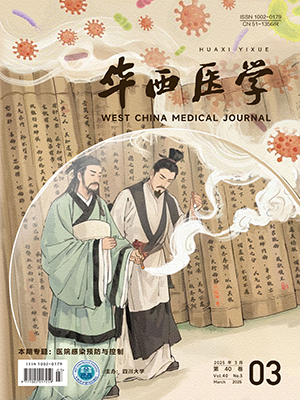Objective To explore the epidemiological characteristics and analyze the related diagnosis and treatment information of wound outpatient cases in a tertiay hospital in Leshan City.Methods The data of cases admitted to the wound clinic in a tertiary hospital of Leshan City between January 1st, 2017 and December 31st, 2019 were retrospectively collected. The SPSS software was used for statistical analyses in terms of basic patient information, wound type and dressing use, number of visits and expenses.Results A total of 10 880 cases were enrolled. The average age of the patients treated was (45.23±13.45) years old. Patients from the Central District, where the hospital was located in, accounted for the highest proportion (38.63%). The proportion of acute skin and soft tissue injuries was higher than that of chronic skin and soft tissue injuries (62.51% vs. 37.49%). According to the proportions from high to low, the top three chronic skin and soft tissue injuries were postoperative refractory wounds (19.63%), skin and soft tissue infections (3.90%), and stoma complications (3.04%), respectively. A total of 22 937 functional wound dressings were used, of which non-woven outer dressings accounted for 47.52%. Patients with acute skin and soft tissue injuries had a higher healing rate compared with those with chronic skin and soft tissue injuries (96.65% vs. 43.03%, P<0.05). The type of skin and soft tissue injuries with the most visits was cancerous wound [the median (lower quartile, upper quartile) was 68 (35, 121) visits], and the one with the least visits was acute skin and soft tissue injuries [the median (lower quartile, upper quartile) was 2 (1, 7) visits].Conclusions As the distance between residence and hospital grows, the number of patients decreases, suggesting that the specialized nursing assistance has achieved initial results in remote areas, but the task of assistance in surrounding areas is still heavy. The type of skin and soft tissue injuries is changing under the concept of enhanced recovery after surgery, and wound care plays an important role in the recovery of patients after surgery. The concept of wet healing and new dressings to promote wound healing are widely used, but still need to be further popularized among patients and medical staff. For chronic wounds that are more expensive to treat, it is necessary to formulate comprehensive treatment plans such as wound treatment, psychological support, and systemic nutrition to promote healing.
Citation:
CHEN Bing, CHEN Miao, ZENG Yangyang, RUAN Xiaoling, LIAO Qian. Retrospective analysis of wound outpatient cases from a tertiay hospital of Leshan City. West China Medical Journal, 2021, 36(4): 465-470. doi: 10.7507/1002-0179.202103146
Copy
Copyright © the editorial department of West China Medical Journal of West China Medical Publisher. All rights reserved
| 1. |
Lindholm C, Searle R. Wound management for the 21st century: combining effectiveness and efficiency. Int Wound J, 2016, 13(Suppl 2): 5-15.
|
| 2. |
姚远. 住院创伤病人流行病学特点及严重创伤结局研究. 重庆: 第三军医大学, 2011.
|
| 3. |
贾赤宇, 柴家科. 以循证医学的视角分析我国目前创面修复领域的不足及改进对策. 创伤外科杂志, 2007, 9(4): 379-381.
|
| 4. |
Shai A, Maibach H. Wound healing and ulcers of the skin diagnosis and thempy. Berlin: Springer, 2005: 31-48.
|
| 5. |
Trostrup H, Bjarnsholt T, Kirketerp-Moller K, et al. What is new in the understanding of non healing wounds epidemiology, pathophysiology, and therapies. Ulcers, 2013, 2013: 1-8.
|
| 6. |
Gottrup F. A specialized wound-healing center concept: importance of a multidisciplinary department structure and surgical treatment facilities in the treatment of chronic wounds. Am J Surg, 2004, 187(5A): 38S-43S.
|
| 7. |
Gottrup F. Organization of wound healing services: the Danish experience and the importance of surgery. Wound Repair Regen, 2003, 11(6): 452-457.
|
| 8. |
冷文玉, 蒋志伟. 某医院患者来源分析. 中国病案, 2015, 6: 53-56.
|
| 9. |
张义丹, 孙扬, 童俊东, 等. 日间手术模式对医疗费用控制的作用机制研究. 中国卫生经济, 2020, 39(4): 23-25.
|
| 10. |
李娜. 手术切口感染的相关因素及门诊换药的护理措施研究. 国际感染病学(电子版), 2020, 9(2): 288-289.
|
| 11. |
江志伟, 李宁, 黎介寿. 快速康复外科的概念及临床意义. 中国实用外科杂志, 2007, 27(2): 131-133.
|
| 12. |
崔婷. 新型敷料治疗慢性创面中的效果分析. 饮食保健, 2019, 6(30): 34-35.
|
| 13. |
陈冰, 罗娜, 孙伟龙, 等. 10% 氯化钠在Ⅲ期压疮清创期的应用研究. 华西医学, 2015, 30(10): 1818-1821.
|
| 14. |
潘玉霞, 王萍. 伤口湿性愈合理论在门诊换药护理中的应用. 中国卫生标准管理, 2018, 9(18): 191-192.
|
| 15. |
杨义, 郝岱峰, 褚万立, 等. 2017 年度北京市某三甲医院创面修复专科住院病例回顾分析. 中华损伤与修复杂志(电子版), 2019, 14(5): 344-349.
|
| 16. |
邓汇典. 普外科腹部术后切口感染的影响因素分析. 基层医学论坛, 2020, 24(10): 1400-1401.
|
- 1. Lindholm C, Searle R. Wound management for the 21st century: combining effectiveness and efficiency. Int Wound J, 2016, 13(Suppl 2): 5-15.
- 2. 姚远. 住院创伤病人流行病学特点及严重创伤结局研究. 重庆: 第三军医大学, 2011.
- 3. 贾赤宇, 柴家科. 以循证医学的视角分析我国目前创面修复领域的不足及改进对策. 创伤外科杂志, 2007, 9(4): 379-381.
- 4. Shai A, Maibach H. Wound healing and ulcers of the skin diagnosis and thempy. Berlin: Springer, 2005: 31-48.
- 5. Trostrup H, Bjarnsholt T, Kirketerp-Moller K, et al. What is new in the understanding of non healing wounds epidemiology, pathophysiology, and therapies. Ulcers, 2013, 2013: 1-8.
- 6. Gottrup F. A specialized wound-healing center concept: importance of a multidisciplinary department structure and surgical treatment facilities in the treatment of chronic wounds. Am J Surg, 2004, 187(5A): 38S-43S.
- 7. Gottrup F. Organization of wound healing services: the Danish experience and the importance of surgery. Wound Repair Regen, 2003, 11(6): 452-457.
- 8. 冷文玉, 蒋志伟. 某医院患者来源分析. 中国病案, 2015, 6: 53-56.
- 9. 张义丹, 孙扬, 童俊东, 等. 日间手术模式对医疗费用控制的作用机制研究. 中国卫生经济, 2020, 39(4): 23-25.
- 10. 李娜. 手术切口感染的相关因素及门诊换药的护理措施研究. 国际感染病学(电子版), 2020, 9(2): 288-289.
- 11. 江志伟, 李宁, 黎介寿. 快速康复外科的概念及临床意义. 中国实用外科杂志, 2007, 27(2): 131-133.
- 12. 崔婷. 新型敷料治疗慢性创面中的效果分析. 饮食保健, 2019, 6(30): 34-35.
- 13. 陈冰, 罗娜, 孙伟龙, 等. 10% 氯化钠在Ⅲ期压疮清创期的应用研究. 华西医学, 2015, 30(10): 1818-1821.
- 14. 潘玉霞, 王萍. 伤口湿性愈合理论在门诊换药护理中的应用. 中国卫生标准管理, 2018, 9(18): 191-192.
- 15. 杨义, 郝岱峰, 褚万立, 等. 2017 年度北京市某三甲医院创面修复专科住院病例回顾分析. 中华损伤与修复杂志(电子版), 2019, 14(5): 344-349.
- 16. 邓汇典. 普外科腹部术后切口感染的影响因素分析. 基层医学论坛, 2020, 24(10): 1400-1401.




